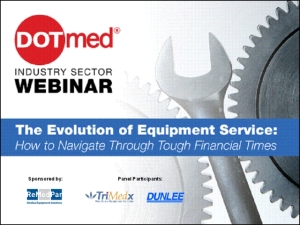by
Kathy Mahdoubi, Senior Correspondent | November 18, 2009

DOTmed presented
an informative webinar
Wednesday on medical
equipment service, sponsored
by ReMedPar
More than 100 attendees joined DOTmed Wednesday for a webinar titled "The Evolution of Equipment Service: How to Navigate Through Tough Financial Times," sponsored by ReMedPar, with panelists Jay Oyakawa, ReMedPar chief of operations and business development; Tom Spees, U.S. sales director for Dunlee; and Mike Kintner, TriMedx director of supply chain.
The event presented detailed data and in-depth dialogue about the health of the health care industry and trends in medical equipment service.
(To watch the webinar, click
here.)
Data-Rich Presentation
The U.S. Healthcare Industry is one-sixth of the economy and a $2.4 trillion business, but that does not protect the industry from today's economic challenges. According to a recent American Hospital Association survey, 34 percent of hospitals expect to report losses in the first half of 2009. These were among data delivered in the webcast.
DOTmed's webinar was aimed at discussing how the recession is impacting hospitals and what health care organizations are doing to cut their costs; it also sought to explore strategies for reducing expenditures on equipment parts and service.
Many of the attendees responded to live surveys conducted during the webinar. In one survey, 43 percent of respondents said their operating expenditures were being reduced as a result of the recession; 39 percent said there was a significant impact on their capital spending, and 28 percent said there were reductions in their workforce.
Mike Kintner said that reduced operating expenditures is "present at all levels," with broad changes occurring in the areas of consumables, technical training and equipment service, whether provided by the OEM, a full-service provider or ISO. "This is a really attractive option for health care systems," he says of alternative medical equipment service providers. "When you do the math at a 5 percent margin, a $100,000 expense reduction has an equivalent impact to the bottom line as $2 million in new revenue."
The webinar also covered the issue of balancing the risks and costs of service associated with OEM, multi-vendor, and full-service providers, and ISOs in relation to the lifecycle of the equipment, and how hospitals and IDNs can go about sourcing high-quality, low-cost parts.
"There are financial pressures for organizations to perform," said Kintner. "[Hospitals and IDNs] are getting much more aggressive because they know they have to."
